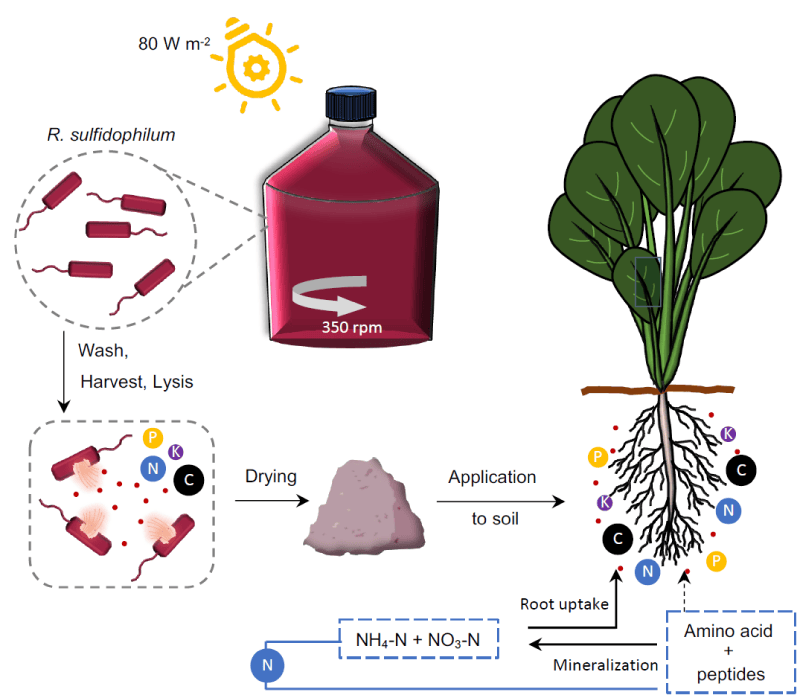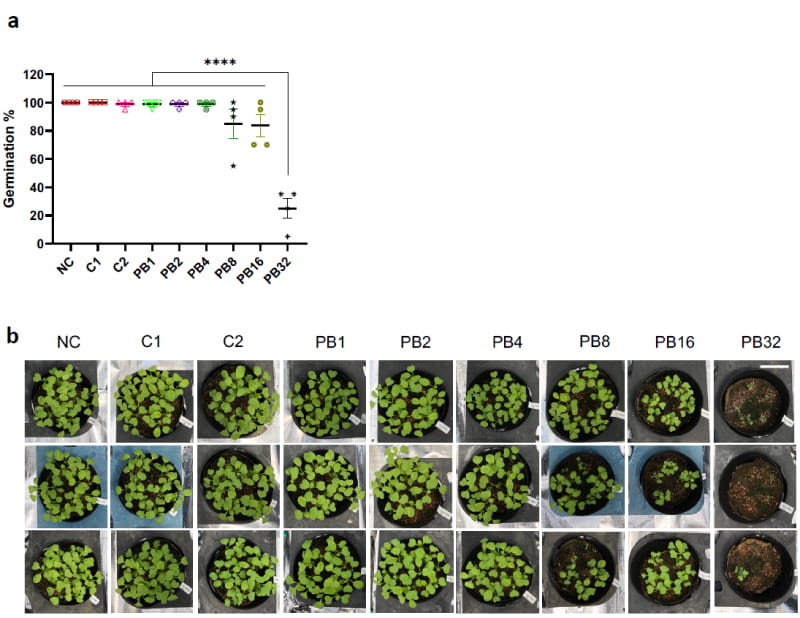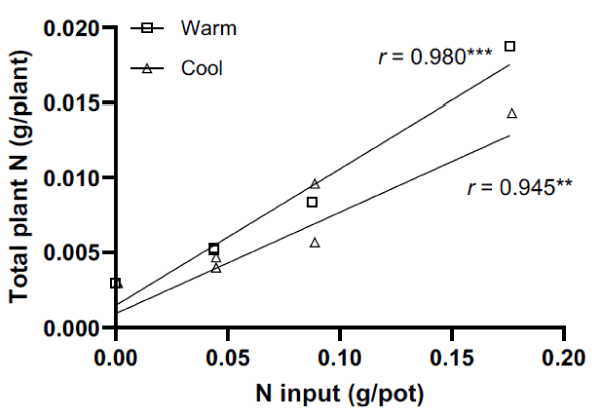Research Results
Photosynthetic Bacteria as Nitrogen Fertilizers
Utilization of Nitrogen-fixing Bacteria as an Alternative Source of Inorganic FertilizersFY2025

- NUMATA Keiji (Professor, Graduate School of Engineering, Kyoto University)
- COI-NEXT
- Project Leader (2023-2032), “Zero-carbon Bioindustry”
Development of Sustainable Nitrogen Fertilizer Using Photosynthetic Bacteria
A research group led by Keiji Numata, Professor at Graduate School of Engineering, Kyoto University and Team Leader at the RIKEN Center for Sustainable Resource Science, demonstrated that the biomass*1 of the marine purple non-sulfur photosynthetic bacterium (Rhodovulum sulfidophilum) can be used as nitrogen fertilizer for crop cultivation.
Marine purple non-sulfur photosynthetic bacteria are capable of fixing atmospheric nitrogen and carbon dioxide, and the lysed and dried biomass contained nitrogen by as much as 11% (weight ratio). The group confirmed that when this biomass is used as fertilizer, plants directly take up nitrogen derived from the biomass (Fig.1). Even when this biomass was given at an amount equivalent to four-fold that of inorganic fertilizers*2, no adverse effects on plant germination and growth were observed.
These research results may contribute to the development of sustainable nitrogen fertilizers as an alternative to existing nitrogen fertilizers.
*1 Biomass
Renewable organic matter produced through the growth of microorganisms, plants, and animals.
*2 Inorganic fertilizer
Inorganic substances consisting of essential nutrients that are applied to the soil and facilitates plant
absorption to improve crop quality.

Fig.1 Lysis, Drying, and Plant Uptake of Photosynthetic Bacteria Used as Fertilizer
Current Issues in Agricultural Fertilizers
Nitrogen is crucial for plant growth, but few plants can directly use nitrogen, which accounts for approximately 78% of the air. The process of converting atmospheric nitrogen into more usable molecules is called nitrogen fixation. Since bacteria capable of nitrogen fixation (rhizobia) live symbiotically in the roots of Fabaceae plants, a method known as green manure was also used in the past, whereby the Fabaceae species Astragalus sinicus was grown and used as fertilizer by plowing it under farmland.
Current agriculture relies heavily on chemically synthesized inorganic fertilizers to mass produce crops. However, production and use of inorganic fertilizers pose the problem of significantly burdening the environment. For example, soil quality is known to diminish when inorganic nitrogen flows into the soil due to excessive use of inorganic fertilizers. Additionally, excess nitrogen in the soil is converted into dinitrogen monoxide (N2O), which contributes to emission of greenhouse gas.
Organic fertilizers*3 such as compost supply nutrients to plants and improve soil structure, but their efficiency is reliant on the ratio of carbon (C) to nitrogen (N) (CN ratio: C/N). Commonly used organic fertilizers often have low nitrogen content and thereby require use of the organic fertilizer in large amounts. As a result, substances including salt content in fertilizers cause problems such as soil salinity*4 and nutritional toxicity*5. On the other hand, organic fertilizers with high C/N ratio may increase dinitrogen monoxide emission in the soil. Given these problems, there has been a need for organic fertilizers with high nitrogen content and low C/N ratio as an alternative to inorganic fertilizers.
*3 Organic fertilizer
Fertilizers derived from microorganisms, plants, animals, or other living organisms, or their excrement.
*4 Soil salinity
Salt content in the soil. Excessive accumulation of soluble salt in the soil interferes with plant growth.
*5 Nutritional toxicity
Presence of excessive elements or nutrients beyond what plants require, causing reduced growth and quality.
Verification of the Potential Use of Purple Non-sulfur Photosynthetic Bacterium Biomass as Organic Fertilizer
To assess whether lysed and dried biomass of purple non-sulfur photosynthetic bacteria could be used as fertilizer, the research group used Japanese mustard spinach (komatsuna, Brassica rapa var. perviridis) to investigate the effects on plant germination and growth. Results showed that even the use of an amount equivalent to four times that of inorganic fertilizers demonstrated no adverse effects on germination (Fig.2a) and growth (Fig.2b).
Additionally, because biomass of purple non-sulfur photosynthetic bacteria releases nitrogen more slowly than inorganic fertilizers, its application in an amount twice that of inorganic fertilizers was found to induce growth comparable to that with inorganic fertilizers in both cool and warm cultivation conditions.
Further, a correlation analysis of the nitrogen content in plants and the amount of nitrogen added to the soil (Fig.3) confirmed that komatsuna takes up nitrogen from the biomass of purple non-sulfur photosynthetic bacteria under both cool and warm conditions.
These results demonstrated that biomass of purple non-sulfur photosynthetic bacteria can be used as organic fertilizer in replacement of inorganic fertilizers.

Fig.2 Effect of Purple Non-sulfur Photosynthetic Bacterial Biomass on Germination and Growth of Komatsuna Komatsuna germination rate (a) and growth (b) at 7 days after sowing. NC: Nitrogen-free fertilizer, C1-2: Inorganic fertilizer, PB1-32: Purple non-sulfur photosynthetic bacterial biomass (1, 2, 4, 8, 16, and 32 represent an added amount of fertilizer corresponding to the amount of nitrogen in inorganic fertilizers). **** indicates a statistically significant difference in germination rate between PB32 and other fertilizers. PB is an abbreviation for processed biomass.

Fig.3 Correlation Between Nitrogen Content in Plants and Nitrogen Contents Added as Purple Non-sulfur Photosynthetic Bacterial BiomassThe graph shows figures at warm conditions (22-32 degrees; upper line) and cool conditions (15-25 degrees; lower line). The vertical axis represents the amount of nitrogen contained in the plant (Komatsuna), and the horizontal axis represents the amount of nitrogen added as biomass.
Anticipation for the Development of a Nitrogen Fertilizer That Contributes to Zero-carbon Agriculture
These results suggest that fertilizers utilizing the nitrogen fixation ability of purple non-sulfur photosynthetic bacteria are promising as a sustainable alternative means that can address both environmental concerns and food security concerns. This fertilizer is predicted to emit less N2O and CO2 than conventionally used other organic fertilizers such as compost and therefore expected to potentially mitigate the impact of agriculture on the environment in the long term.
To evaluate purple non-sulfur photosynthetic bacterial biomass in terms of suitability as a commercial alternative to inorganic fertilizers and economic viability, the research group will address latent challenges going forward, including expansion of the culture scale, assessment of contamination risks and shelf life, and variability in efficacy at different temperatures.
Additionally, Symbiobe Inc., a startup by Kyoto University, is currently working to establish mass production technologies for purple non-sulfur photosynthetic bacteria.
These efforts are expected to result in the sustainable nitrogen fertilizers as a new option that substitutes chemical fertilizers and to contribute to the promotion and advancement of zero-carbon agriculture.
- Environment and Energy
- Research Results
- Japanese
